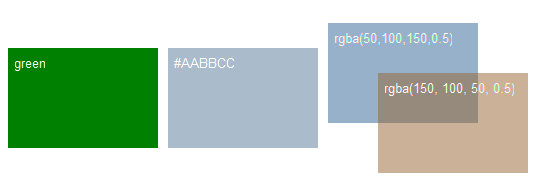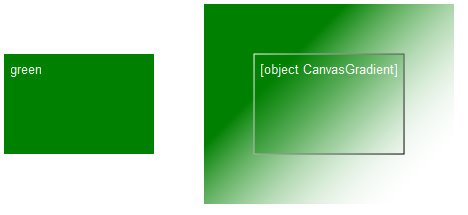在 Canvas 中,颜色主要用途就是在绘制路径时,用来指定填充颜色和边框颜色。
Canvas 中的颜色参数值有两种格式:
1. 如果透明度为 1.0,也就是不透明,颜色值的格式就与一般使用一样,为:#AABBCC,其中 AA、BB、CC 分别为 Red、Green、Blue 分量。
2. 如果透明度不为 1.0,也就是带透明,颜色值格式可以使用 rgba(r, g, b, a),其中 r、g、b、a 分别为 Red、Green、Blue 分量和透明度。透明度的值为 0 至 1.0 之间的一个数值。
3. 颜色值还可以为已知的颜色名称,例如 red、blue、green 等。
总的说来,Canvas 中颜色值的格式与 CSS 中一致,因此颜色值没有特别需要注意的地方。

注意,以上代码需要使用 Firefox 3.5 来查看,在 Firefox 3.0.x 中,Canvas 的 Context 对象不支持 fillText 方法,而我安装的 Chrome 2.0.174.0 对 translate 方法的实现有误。
2. Canvas 中的渐变
WHATWG 的 Canvas 规范中规划了两种渐变模式,一种是线性渐变,另一种是径向渐变。如果需要在 Canvas 中使用渐变,首先要根据你所要创建的渐变模式来调用 Context 的相应方法来创建一个渐变对象,这个对象就是用来控制渐变的效果。
2.1 线性渐变
线性渐变使用 Canvas Context 的 createLinearGradient 方法创建,它的定义如下:
CanvasGradient createLinearGradient(in float x0, in float y0, in float x1, in float y1);
通过 (x0, y0) 与 (x1, y1) 指定渐变的开始位置与截止位置。当然,创建完线性渐变对象并不能完全开始使用渐变对象,你需要给它指定渐变的起始色以及终止色。CanvasGradient 对象有一个 addColorStop 方法用来添加颜色。
gradient.addColorStop(offset, color)
在线性渐变中,偏移量 offset 只能取 0 或 1,分别代表线性渐变的起始色和终止色。color 参数的值可以参考上面说明的颜色格式。
例如,我要创建一个从 (20, 20) 到 (150, 150) 的一个渐变,从绿色渐变到白色透明,就可以按照下面的代码来创建 CanvasGradient 对象:
- var gradient = ctx.createLinearGradient(20, 20, 150, 150);
- gradient.addColorStop(0, 'green');
- gradient.addColorStop(1, 'rgba(255,255,255,0)');
创建完渐变对象后,可以直接将它赋值给 CanvasContext 的 fillStyle 属性或 strokeStyle 属性,用来指定填充的渐变色或画边框的渐变色。也就是说,CanvasGradient 对象的用法等同于颜色参数值,通过赋值给 Context 对象来起作用。

2.2 径向渐变
与线性的用法类似,它的函数签名如下:
CanvasGradient createRadialGradient(in float x0, in float y0, in float r0, in float x1, in float y1, in float r1);
与线性渐变不同的是,径向渐变除了要指定起始位置和终止位置外,还需要指定起始半径和终止半径。使用不同中心点的径向渐变可以实现类似光照的效果,不过目前 Chrome 对不同中心点的径向渐变支持不好,在 Chrome 中只会使用第二个中心点进行径向渐变,测试发现在最新开发版 Chrome 3.0.184.0 (17842) 中仍是如此。
在下图中可以看到,主流支持 Canvas 的浏览器都能正确渲染中心点不同的径向渐变,而 Chrome 则只能使用第二个中心点进行渲染。
小结
总的来说,Canvas 中的颜色使用与使用 CSS 进行颜色定义没有什么区别,但比较强大的是 Canvas 支持渐变,这样就可以通过 Canvas 来做一些比较炫的效果。
这篇拖的太久了,已经有些忘了,先结束掉这部分再继续写了……
 HTML5 and H5: Understanding the Common UsageApr 22, 2025 am 12:01 AM
HTML5 and H5: Understanding the Common UsageApr 22, 2025 am 12:01 AMThere is no difference between HTML5 and H5, which is the abbreviation of HTML5. 1.HTML5 is the fifth version of HTML, which enhances the multimedia and interactive functions of web pages. 2.H5 is often used to refer to HTML5-based mobile web pages or applications, and is suitable for various mobile devices.
 HTML5: The Building Blocks of the Modern Web (H5)Apr 21, 2025 am 12:05 AM
HTML5: The Building Blocks of the Modern Web (H5)Apr 21, 2025 am 12:05 AMHTML5 is the latest version of the Hypertext Markup Language, standardized by W3C. HTML5 introduces new semantic tags, multimedia support and form enhancements, improving web structure, user experience and SEO effects. HTML5 introduces new semantic tags, such as, ,, etc., to make the web page structure clearer and the SEO effect better. HTML5 supports multimedia elements and no third-party plug-ins are required, improving user experience and loading speed. HTML5 enhances form functions and introduces new input types such as, etc., which improves user experience and form verification efficiency.
 H5 Code: Writing Clean and Efficient HTML5Apr 20, 2025 am 12:06 AM
H5 Code: Writing Clean and Efficient HTML5Apr 20, 2025 am 12:06 AMHow to write clean and efficient HTML5 code? The answer is to avoid common mistakes by semanticizing tags, structured code, performance optimization and avoiding common mistakes. 1. Use semantic tags such as, etc. to improve code readability and SEO effect. 2. Keep the code structured and readable, using appropriate indentation and comments. 3. Optimize performance by reducing unnecessary tags, using CDN and compressing code. 4. Avoid common mistakes, such as the tag not closed, and ensure the validity of the code.
 H5: How It Enhances User Experience on the WebApr 19, 2025 am 12:08 AM
H5: How It Enhances User Experience on the WebApr 19, 2025 am 12:08 AMH5 improves web user experience with multimedia support, offline storage and performance optimization. 1) Multimedia support: H5 and elements simplify development and improve user experience. 2) Offline storage: WebStorage and IndexedDB allow offline use to improve the experience. 3) Performance optimization: WebWorkers and elements optimize performance to reduce bandwidth consumption.
 Deconstructing H5 Code: Tags, Elements, and AttributesApr 18, 2025 am 12:06 AM
Deconstructing H5 Code: Tags, Elements, and AttributesApr 18, 2025 am 12:06 AMHTML5 code consists of tags, elements and attributes: 1. The tag defines the content type and is surrounded by angle brackets, such as. 2. Elements are composed of start tags, contents and end tags, such as contents. 3. Attributes define key-value pairs in the start tag, enhance functions, such as. These are the basic units for building web structure.
 Understanding H5 Code: The Fundamentals of HTML5Apr 17, 2025 am 12:08 AM
Understanding H5 Code: The Fundamentals of HTML5Apr 17, 2025 am 12:08 AMHTML5 is a key technology for building modern web pages, providing many new elements and features. 1. HTML5 introduces semantic elements such as, , etc., which enhances web page structure and SEO. 2. Support multimedia elements and embed media without plug-ins. 3. Forms enhance new input types and verification properties, simplifying the verification process. 4. Offer offline and local storage functions to improve web page performance and user experience.
 H5 Code: Best Practices for Web DevelopersApr 16, 2025 am 12:14 AM
H5 Code: Best Practices for Web DevelopersApr 16, 2025 am 12:14 AMBest practices for H5 code include: 1. Use correct DOCTYPE declarations and character encoding; 2. Use semantic tags; 3. Reduce HTTP requests; 4. Use asynchronous loading; 5. Optimize images. These practices can improve the efficiency, maintainability and user experience of web pages.
 H5: The Evolution of Web Standards and TechnologiesApr 15, 2025 am 12:12 AM
H5: The Evolution of Web Standards and TechnologiesApr 15, 2025 am 12:12 AMWeb standards and technologies have evolved from HTML4, CSS2 and simple JavaScript to date and have undergone significant developments. 1) HTML5 introduces APIs such as Canvas and WebStorage, which enhances the complexity and interactivity of web applications. 2) CSS3 adds animation and transition functions to make the page more effective. 3) JavaScript improves development efficiency and code readability through modern syntax of Node.js and ES6, such as arrow functions and classes. These changes have promoted the development of performance optimization and best practices of web applications.


Hot AI Tools

Undresser.AI Undress
AI-powered app for creating realistic nude photos

AI Clothes Remover
Online AI tool for removing clothes from photos.

Undress AI Tool
Undress images for free

Clothoff.io
AI clothes remover

Video Face Swap
Swap faces in any video effortlessly with our completely free AI face swap tool!

Hot Article

Hot Tools

MantisBT
Mantis is an easy-to-deploy web-based defect tracking tool designed to aid in product defect tracking. It requires PHP, MySQL and a web server. Check out our demo and hosting services.

PhpStorm Mac version
The latest (2018.2.1) professional PHP integrated development tool

MinGW - Minimalist GNU for Windows
This project is in the process of being migrated to osdn.net/projects/mingw, you can continue to follow us there. MinGW: A native Windows port of the GNU Compiler Collection (GCC), freely distributable import libraries and header files for building native Windows applications; includes extensions to the MSVC runtime to support C99 functionality. All MinGW software can run on 64-bit Windows platforms.

mPDF
mPDF is a PHP library that can generate PDF files from UTF-8 encoded HTML. The original author, Ian Back, wrote mPDF to output PDF files "on the fly" from his website and handle different languages. It is slower than original scripts like HTML2FPDF and produces larger files when using Unicode fonts, but supports CSS styles etc. and has a lot of enhancements. Supports almost all languages, including RTL (Arabic and Hebrew) and CJK (Chinese, Japanese and Korean). Supports nested block-level elements (such as P, DIV),

ZendStudio 13.5.1 Mac
Powerful PHP integrated development environment





